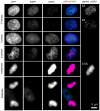Spatiotemporal characterization of ionizing radiation induced DNA damage foci and their relation to chromatin organization
- PMID: 20060491
- PMCID: PMC3951968
- DOI: 10.1016/j.mrrev.2009.12.006
Spatiotemporal characterization of ionizing radiation induced DNA damage foci and their relation to chromatin organization
Abstract
DNA damage sensing proteins have been shown to localize to the sites of DNA double strand breaks (DSB) within seconds to minutes following ionizing radiation (IR) exposure, resulting in the formation of microscopically visible nuclear domains referred to as radiation-induced foci (RIF). This review characterizes the spatiotemporal properties of RIF at physiological doses, minutes to hours following exposure to ionizing radiation, and it proposes a model describing RIF formation and resolution as a function of radiation quality and chromatin territories. Discussion is limited to RIF formed by three interrelated proteins ATM (Ataxia telangiectasia mutated), 53BP1 (p53 binding protein 1) and gammaH2AX (phosphorylated variant histone H2AX), with an emphasis on the later. This review discusses the importance of not equating RIF with DSB in all situations and shows how dose and time dependence of RIF frequency is inconsistent with a one to one equivalence. Instead, we propose that RIF mark regions of the chromatin that would serve as scaffolds rigid enough to keep broken DNA from diffusing away, but open enough to allow the repair machinery to access the damage site. We review data indicating clear kinetic and physical differences between RIF emerging from dense and uncondensed regions of the nucleus. We suggest that persistent RIF observed days following exposure to ionizing radiation are nuclear marks of permanent rearrangement of the chromatin architecture. Such chromatin alterations may not always lead to growth arrest as cells have been shown to replicate these in progeny. Thus, heritable persistent RIF spanning over tens of Mbp may reflect persistent changes in the transcriptome of a large progeny of cells. Such model opens the door to a "non-DNA-centric view" of radiation-induced phenotypes.
Published by Elsevier B.V.
Figures




Similar articles
-
Persistent DNA damage after high dose in vivo gamma exposure of minipig skin.PLoS One. 2012;7(6):e39521. doi: 10.1371/journal.pone.0039521. Epub 2012 Jun 27. PLoS One. 2012. PMID: 22761813 Free PMC article.
-
Clustered DNA damage induces pan-nuclear H2AX phosphorylation mediated by ATM and DNA-PK.Nucleic Acids Res. 2013 Jul;41(12):6109-18. doi: 10.1093/nar/gkt304. Epub 2013 Apr 24. Nucleic Acids Res. 2013. PMID: 23620287 Free PMC article.
-
Growth of persistent foci of DNA damage checkpoint factors is essential for amplification of G1 checkpoint signaling.DNA Repair (Amst). 2008 Mar 1;7(3):405-17. doi: 10.1016/j.dnarep.2007.11.011. Epub 2008 Jan 8. DNA Repair (Amst). 2008. PMID: 18248856
-
Laser-induced radiation microbeam technology and simultaneous real-time fluorescence imaging in live cells.Methods Enzymol. 2012;504:3-28. doi: 10.1016/B978-0-12-391857-4.00001-X. Methods Enzymol. 2012. PMID: 22264527 Review.
-
The influence of heterochromatin on DNA double strand break repair: Getting the strong, silent type to relax.DNA Repair (Amst). 2010 Dec 10;9(12):1273-82. doi: 10.1016/j.dnarep.2010.09.013. Epub 2010 Oct 30. DNA Repair (Amst). 2010. PMID: 21036673 Review.
Cited by
-
Quantification of radiation-induced DNA double strand break repair foci to evaluate and predict biological responses to ionizing radiation.NAR Cancer. 2021 Dec 22;3(4):zcab046. doi: 10.1093/narcan/zcab046. eCollection 2021 Dec. NAR Cancer. 2021. PMID: 35692378 Free PMC article.
-
ATM/Chk2 and ATR/Chk1 Pathways Respond to DNA Damage Induced by Movento® 240SC and Envidor® 240SC Keto-Enol Insecticides in the Germarium of Drosophila melanogaster.Toxics. 2023 Sep 6;11(9):754. doi: 10.3390/toxics11090754. Toxics. 2023. PMID: 37755764 Free PMC article.
-
A human lung alveolus-on-a-chip model of acute radiation-induced lung injury.Nat Commun. 2023 Oct 16;14(1):6506. doi: 10.1038/s41467-023-42171-z. Nat Commun. 2023. PMID: 37845224 Free PMC article.
-
DNA Damage Baseline Predicts Resilience to Space Radiation and Radiotherapy.Cell Rep. 2020 Dec 8;33(10):108434. doi: 10.1016/j.celrep.2020.108434. Epub 2020 Nov 25. Cell Rep. 2020. PMID: 33242409 Free PMC article.
-
Live Cell Imaging of Nuclear Actin Filaments and Heterochromatic Repair foci in Drosophila and Mouse Cells.Methods Mol Biol. 2021;2153:459-482. doi: 10.1007/978-1-0716-0644-5_32. Methods Mol Biol. 2021. PMID: 32840799 Free PMC article.
References
-
- Ashley T, Plug AW, Xu J, Solari AJ, Reddy G, Golub EI, Ward DC. Dynamic changes in Rad51 distribution on chromatin during meiosis in male and female vertebrates. Chromosoma. 1995;104:19–28. - PubMed
-
- Nelms BE, Maser RS, MacKay JF, Lagally MG, Petrini JH. In situ visualization of DNA double-strand break repair in human fibroblasts. Science. 1998;280:590–592. - PubMed
Publication types
MeSH terms
Substances
Grants and funding
LinkOut - more resources
Full Text Sources
Other Literature Sources
Research Materials
Miscellaneous

